Advanced Projects
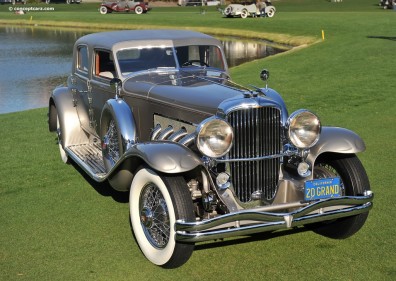
Here is something like the Model A in which Dad drove Mom out to Detroit in 1948 to start their new lives in the Motor City’s rip-roaring auto industry. It was used, of course, having been husbanded by someone through the gas rationing and rubber shortage of the war years. Look at how the design screams “antique,” and yet it was driving around Detroit almost into 1950.
Dad had used the GI Bill to attend Pratt Institute of Design in Brooklyn, and here is one of the rendering that got him hired at Ford’s, based on the recommendation of “Uncle Bob,” who wrote and said: “They are hiring!”
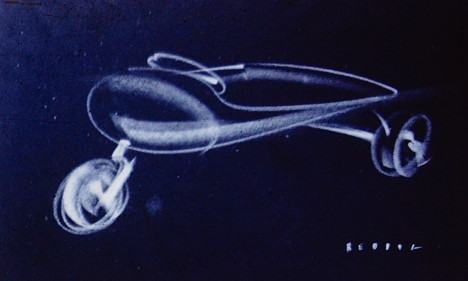
(Rendering of a child’s toy Raven did for his portfolio at Pratt Institute- you can see the sleek lines he loved.)
They packed up that Model A and drove West to Michigan. The road they traveled was partly the Pennsylvania Turnpike, The toll road- the first in America- was planned in the 1930s to improve transportation across the Appalachian Mountains, and used seven tunnels bored through the hills in the 1880s for the abandoned South Pennsylvania Railroad. I could wax eloquent about the Turnpike- and its sister, the Ohio Turnpike, but this just demonstrates how hard it is to separate the cars and the car people and the roads on which we drove.
This is what Dad stepped up to- the sleek 1948 two door I remember from my boyhood:
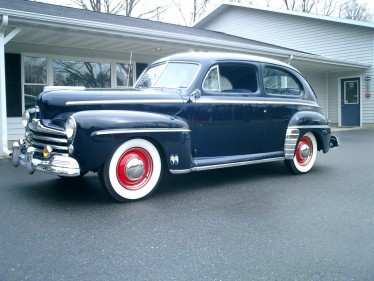
(1948 Ford Tudor. Compare the lines with the Model A. Sleek.)
I will get back to the Dwight Eisenhower Interstate and Defense Highway system some other time- Ike had been a Major on the epic Army convoy across America in 1919 that started near where Big Pink stands today. But I can’t even get back to the seminal moment in my early driving life on Woodward Avenue and I have been trying for more than a week.
Dad joined a talented team of Ford designers- a sample of the way they inducted the young men into the system is in this 1955 account of a tour conducted by Ford’s Alex Tremulis for Henry Ford II (we called him “the Deuce” in Detroit) and members of the Product Planning Committee that his people were on top of the future.
Dad was already over at American Motors by then as assistant head of styling, but the Tremulis orientation to the Advanced Design Studio shows how the system worked. Dad told me that he had worked on some wild things- the turbine-powered Ford and the Levacar among them. I can’t make the timeline work in my head.
The Levacar Mach 1 (a name later applied to a Mustang model) was shown at the Rotunda in 1959- I remember being taken there to see it, but of course it never went anywhere. It was intended to be personal transportation with no wheels, just an air cushion. Top speed was intended to be 500mph, though of course the whole braking concept would have required some sort of vector thrust technology that did not come to the missile industry until the Space Age began in earnest.
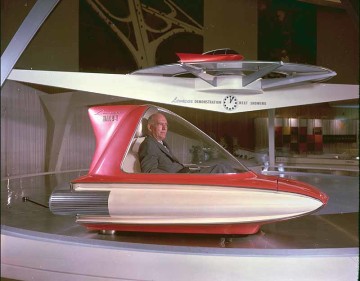
(The Levacar Mach 1, shown at the fabled Ford Rotunda, the Albert Kahn-desinged marvel of the 1934 Worlds Fair that was moved to Dearborn to serve as the entry point to the Ford World Headuarters. It burned to the ground in 1962 shortly after my last visit, which I had nothing to do with. The structure was circled with components of the famous highways of the world, including the Appian Way and the Burma Road. I assume that is still there- and I will get around to visiting the next time I am up there).
There was more from the Advanced design guys- they introduced several versions the year before in 3/8-scal, including the Volante, which supposedly could use three fan motors to levitate from a parking place and take to the air. But the most amazing of these models was the Nucleon. What may have looked like a Continental kit sitting on the large and flat rear deck was the cover for a small nuclear reactor that would power the car through the Atomic Age.
My Pal Tom collects Packards, and is as hard core a car person as you get. He commented on the merger and acquisition strategy among the pre-war legacy carmakers in the go-go 1950s:
“George Mason and James Nance, Packard’s president, had a handshake agreement to resume merger talks once Packard completed the acquisition of Studebaker. Nance was NOT a car person. He came from Hotpoint, where he proved he could make and sell washing machines. He made one unfortunate move after another while at Packard. One of them was a 1956 financial tie-up between the venerable Curtiss-Wright Aircraft company and floundering Studebaker-Packard: an air car to compete with what was happening at Ford’s.
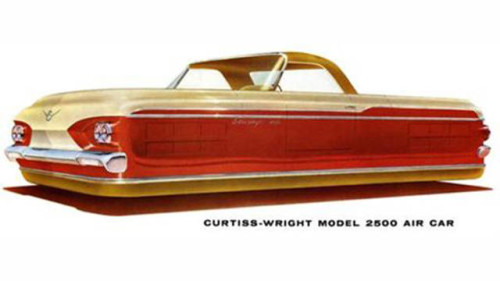
The thing was an enormous, blocky body fashioned after the automotive styling of the day, complete with twin headlights, turn signals, fenders, and bumpers.
That was just one of the things on which Nance blew the Studebaker patrimony.
He completed the Studebaker merger but, by the time he did, Mason had died and a guy named Romney was in charge at AMC. Romney took one look at the Studebaker-Packard merger and cancelled any notion of merging with them. He thought Nance was nuts and had done little or no due diligence before he rushed into the Studebaker deal. Romney was right. In 1956 Packard shut down the Connor Avenue plant that they had just bought from Chrysler for the ’55 and ’56 models and left Detroit for South Bend, IN. They put out a few “Packards” in 57 and 58, but they were just re-badged Studebakers. The 1958 Packard sold fewer than 2,000 cars! And that was the end.
It’s interesting to speculate on what might have happened had Packard (sans Studebaker) merged with AMC in 1954. AMC did not have an entry in the luxury car market, and Packard could have filled that niche. Other than the periodic re-appearance of the never-very-successful Imperial, Chrysler didn’t have a true luxury car either. Perhaps the Packard brand could still be alive as part of Chrysler Corporation!
Always interesting to speculate on what might have been. In any case, the demise of Packard is a case-book study on mis-managing a company which was profitable in 1954 and gone in 1958!”
Sigh. That is how it goes, trying to capture a century of cruising around America. I was going to talk to you about Fins today, and wound up over with the Levacar. They were exciting times. Just imagine if the old heap on blocks in the side yard came with a nuclear reactor. It would be like the vast fleet of hulk nuclear submarines sinking at the piers in the former Soviet Union.
But of course, all markets have their cycles, don’t they? Russia seems to be carving out an increasing market share these day, you know?
Back to Dad and the fins and where they came from tomorrow.
Copyright 2014 Vic Socotra
www.vicsocotra.com
Twitter: @jayare303
Car People
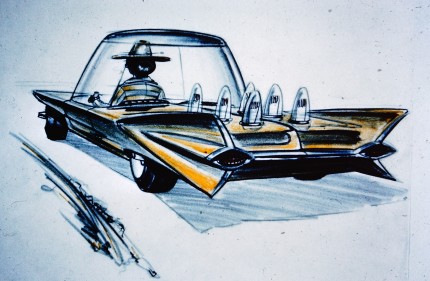
(One of Dad’s concept cars- the Tesla electric car of 1958!)
We were car people- in Detroit, of Detroit, the Fathers all had auto contracts with their companies that included a new car every year. We had a flood of new vehicles through the suburbs, and we were quite opinionated about all of them. “Knowledgeable consumers,” I guess you would say, since what the family drove- and what we were about to driving ourselves, determined your caste and status.
I had the Sports Car Club of America badge on the grill of the 1973 Chevy Caprice Classic for the years I owned it- it was Raven’s from the early ‘fifties, back when he wanted to drive something as hot as the A-1 Skyraider he flew in the Naval Reserves at NAS Grosse Isle.
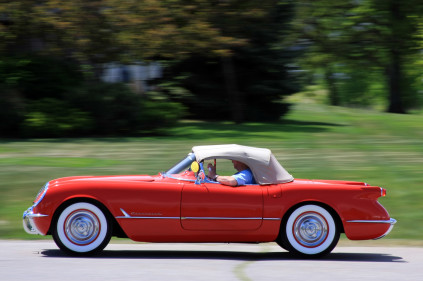
He was not alone. Here is an example: It was not unusual to come home from school to find a first-year-of-production 1954 Corvette flanked by a couple other exotics. The Corvette belonged to “Uncle” Bob- he was on the design team that brought Harley Earl’s idea from concept car to reality. Originally designed as a show car for the 1953 Motorama display at the New York Auto Show, it generated enough interest that to GM made the decision to sell to the public. To keep costs down, GM executive Robert F. McLean mandated off-the-shelf mechanical components, and used the chassis and suspension from the 1952 Chevy sedan.
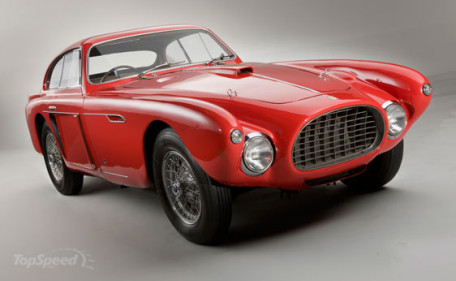
The Vette sat next to the 1952 Ferrari Mexico Coupe. I don’t know who owned it the exotic beauty- one of the guys who was still in the AMC design shop. They were built exclusively for the 1952 Carrera Panamericana race in Mexico – which was one of the most deadly races in the world. I wish I could ask Raven who it was. I remember listening to an intricate story about differential fluid in which the men were nodding earnestly. One of these Ferraris just went for several million bucks at auction.
And, of course, next to them both was a 1963 Studebaker Avanti:
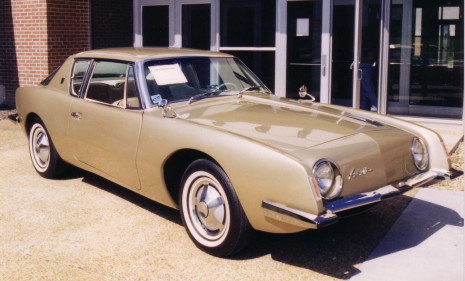
Some good pals still have one of these quirky classics in their garage Up North. Dad had one back in the day for a two-week “evaluation” when they were new- production ran from June 1962 through December 1963. Studebaker called their sleek car “America’s Only 4 Passenger High-Performance Personal Car!” in the sales literature, and the model was developed at the direction of the automaker’s president, Sherwood Egbert. They combined safety and elegance and performance- a little taste of what was going to come in the golden age of modern Detroit iron.
The two real sports cars were nearly a decade old, and were a taste of what was to come in the automotive world. In fact, the production run for the Avanti may date this recollection to the summer of 1963. The guys may have come over to check out the offering that was very cool but could not save the Studebaker marque. After years of trouble the company merged with the legendary Packard Motors, in 1954.
Hudson-Rambler president George Mason had his eye on both companies, but in the end they all went down. The Studebaker South Bend plant ceased production on December 20, 1963, and the last Studebaker automobile rolled off the Hamilton, Ontario, Canada, assembly line on March 16, 1966. The Studebaker, Cord, Auburn and Duesenberg companies remind me that “Detroit” was actually an arc of assembly and fabrication plants that stretched from the Motor City through Ohio and into Little Detroit: the great motoring state of Indiana.
Heck, I belong to the Hoosier AMC Club, not the one in Michigan. They are passionate people, and great friends.

(1933 Duesenberg SJ Coup. They could be had for a song after World War II when new cars became available again.)
Dick Teague, Dad’s boss in the styling shop at AMC collected Duesenbergs- he started after the war when some real gems that had been flogged through the War when there were no civilian vehicles produced came on the market. Mom and Dad drove a 1936 Model A with a drop top out to Detroit from Borrklyn when they came to work at Ford’s in 1948, and I still remember when they sold their first new car- the iconic 1948 Ford- to a kid down the block.
Chicago documentary producer Scott Craig did an account of the last days of a proud company as Studebaker succumbed to the implacable forces of the market, and the unions and the economy of scale. His Peabody Award-winning special, “Studebaker: Less Than They Promised,” brings a human face to what all of us who saw the institutions that put bread on the table die still feel. That includes the once magnificent city of Detroit.
At the time we had a Rambler Ambassador Station Wagon and the Rambler American compact sedan as the second car.
I am confident that it was the exposure to the real sports cars that convinced Dad to buy the 343 Javelin a couple years later, which considering what I did out on Woodward in Bloomfield Hills in that Charger 440 R/T to be sort of curious.
But we were car people, after all. It is what we did.
Copyright 2014 Vic Socotra
www.vicsocotra.com
Twitter: @jayare303
And Still Champion
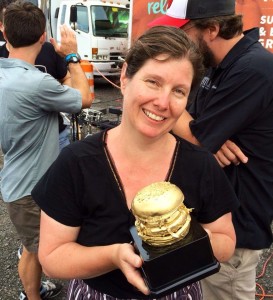
(Tracy has been cooking all afternoon. That is not the winning burger- it is the trophy. Last year’s was a four-foot-tall bowling trophy. Photo Willow).
“A GROUND ROUND SMACKDOWN FEATURING TEN OF THE BEST BURGER SLINGERS IN THE DMV.”
No, not the Department of Motor Vehicles. That would make no sense. DiMarVA, they mean- the District, Maryland and Virginia.
That was the blurb for the big burger competition this year. The guys over at Big Buns- an occasional treat when we worked in the building almost next store in Ballston- were the sponsors and clearly itching to avenge their defeat.
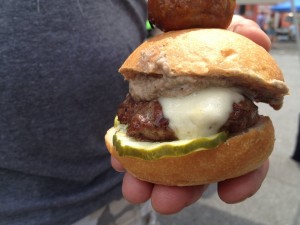
(A not-so-mini burger with Brian’s hand. Photo Willow).
Last year’s contest of the titans was right here in Arlington, and Willow kicked burger ass to win it all- a surprise for anyone used to thinking about Tracy O’Grady’s place as exclusively a venue for fine dining. Tracy had the unenviable task of defending her title after winning with a double-smoked, pan-seared-in-duck-fat masterpiece.
It went down this year on Florida Avenue in the hip Shaw neighborhood. I missed it- I was engaged in weed eradication projects at the farm, and was amazed last night to discover they had done it again.
Ticket holders to the event got to try FIVE or ALL TEN “not-so-mini burgers,” depending on how much you paid. The grounf rules said that the custom-built gourmet creations contained 3 oz. of blended beef bliss and up to five toppings. The competing restaurants were loaded for bear.
The crowd munched while “sampling great craft beer and enjoying live tunes in the sunshine.”
There was a vote at the end of it all, and y popular vote, Willow Restaurant won FIRST PLACE at the DC BRGR BASH! The winning cast of culinary masters included: Tracy, Brian Wolken, Debra Spetz Rubin, Heather Small, Kate Jansen and Miguel Antunez.
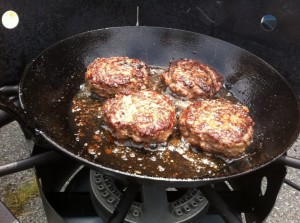
Honorable mention goes to some great also-rans from:
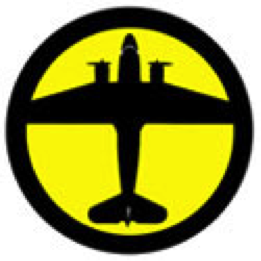
Cafe Saint-Ex
14th Street
Known for their local, dry-aged burger, this contemporary French-American bistro represents 14th Street with pride.
http://twitter.com/cafesaintex

BIG BUNS
Arlington
Customized burgers earned this Ballston favorite a WaPo “Best Bet” and WTOP “Top 10 Burgers in the DMV”.
http://twitter.com/eatbigbuns

Boundary Stone
Bloomingdale
All-natural, hand-ground burgers from this neighborhood gem named a Best of DC “Best Place to Eat at the Bar”.
http://twitter.com/boundarystonedc
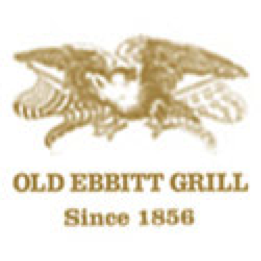
Old Ebbitt Grill
Downtown
Executive Chef Sal Ferro showcases updated American cuisine (and a mighty tasty locally raised grass-fed beef burger) at one of DC’s oldest and best-known saloons.
http://twitter.com/oldebbitt
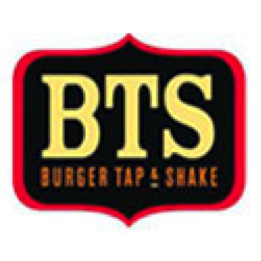
Burger Tap & Shake
Foggy Bottom
One bite of the house ‘Six Buck Chuck’ and you’ll see why that line snaking down the block on Washington Circle is worth standing in.
http://twitter.com/burgertapshake
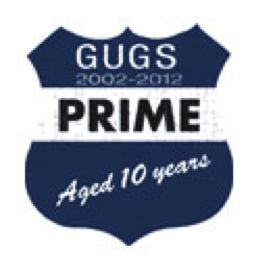
GUGS
Georgetown
Thick, juicy, no-frills burgers from the Georgetown University Grilling Society have made this local crew a G’town institution.
http://twitter.com/gugs_georgetown
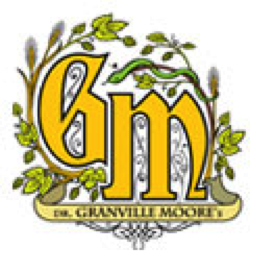
Granville Moore’s
H Street
“A gastropub with a healthy Belgian Fetish”, this popular H Street tavern run by Chef Teddy Folkman needs little introduction.
http://twitter.com/granvillemoores
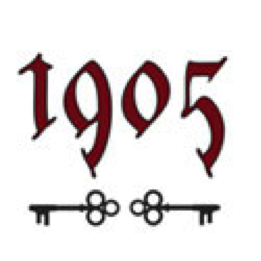
1905
Shaw
Double-patty delights and signature bacon-fried onions have earned this intimate bistro newcomer a reputation as “One to Watch”.
http://twitter.com/1905dc

Fainting Goat
U Street
Run by Chef Nathan Beauchamp, this popular U Street gastropub does simple food with a gourmet twist and was recently praised by WaPo critic Tom Sietsema.
Willow’s Burger Battle winner secret ingredient? I had a tip from Heather on Friday: roast garlic duck confit butter.
Come and get it!
Copyright 2014 Vic Socotra
www.vicsocotra.com
Twitter: @jayare303
Pony Cars
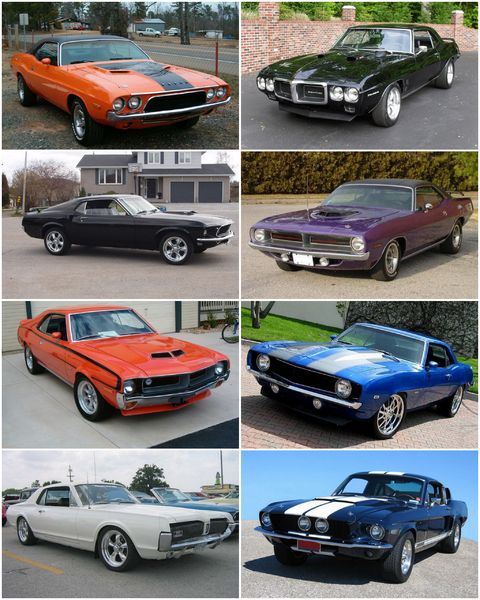
I will never forget the night we abandoned George’s ’66 Mustang up in the Maine woods on the road to Belfast. The 289 cubic inch engine gave up the ghost on us in the dark in 1975. We were at loose ends, as recent graduate of college and had not quite figured out what to do with the rest of our lives, and were not smart enough to be apprehensive about it yet.
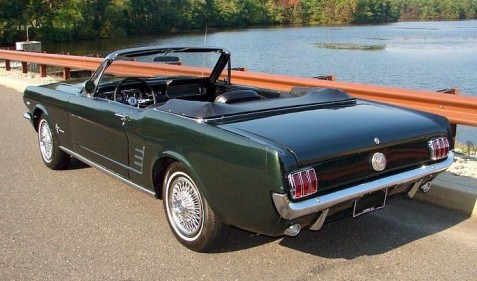
There is nothing wrong with that, but the ignominious end of that great little green convertible made us all sad. We had no time- or money- to repair it and gave a quit-claim transfer on the title to some local folks on the road to just take the thing, and get us a ride to mass transportation- or thumb. We thought nothing about hitch-hiking then, go figure.
Let me be frank: we beat the crap out of those cars. We did not take care of them, since the salt of a Michigan winter ate them alive, rust splotches starting when they were only a few years old. We knew viscerally the lesson that nothing lasts- body or engine, it was all going to go the way of entropy. The cars were disposable things, their might and sleek styling notwithstanding.
The Mustang had started so beautifully- the dawn of an age of motoring that coined its own name- the Pony Car era. The montage above has the usual suspects. They didn’t start out as behemoths of speed; the Mustang was actually a fairly modest performer Cougars, Mustangs, Camaros, Firebird, Before we get any further, let’s get something straight about what we are talking about here. There were the Ponies- the ones that responded to Ford’s dramatic introduction as the “1965 ½” Mustang. It was a pert little ride so wildly popular that Ford was forced to attach the iconic logo gas cap to the car with a sturdy cable to avoid people like me from unscrewing them and taking them home.
Detroit was all about meeting market needs- the next step up from the Ponies was a class of mid-size footstompers- like Dick’s Charger, the Torino GT, Mercury Cyclone, the Pontiac Goats, Chevelle SS, Plymouth Road Runner, Buick Grand Sport and the sleek Olds 442.
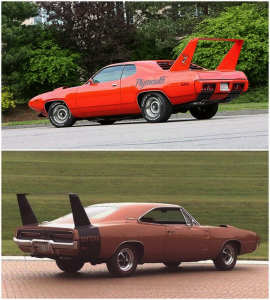
Standing alone was the Corvette- the most assertively aberrant car until the Dodge Viper. And the two full-out hallucinations from Chrysler; the Plymouth Superbird and Dodge Charger Daytona.Real race cars, sold right at the neighborhood Chrysler dealer.
Two of my idiot buddies lunched the hemi-powered Superbird that belonged to a teacher who had what now would be considered an equally aberrant interest in testosterone-crazed teenaged boys. Something about not having oil in the engine- but to me, nothing ever said Detroit Crazy like having a Daytona blow by you at more than a hundred miles an hour on I-75 headed north.
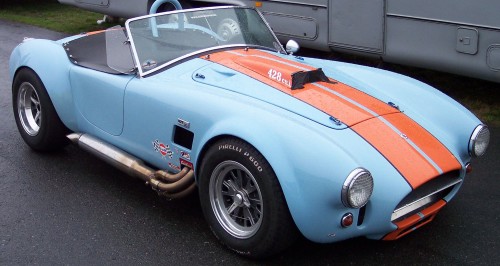
There were other exotics- the 427 Shelby Cobra being my personal favorite, which followed the same general idea that the lunatics at AMC did, which was to find the lightest body and frame that could accommodate the biggest possible engine.
I had a ride in a Cobra one time, and discovered that the torque actually serve to turn the car to the right when the accelerator was depressed with alacrity. They were rockets, those things, and the sense of being crushed back into your bucket seat- or like the Charger 440 R/T, being able to burn rubber at a standstill by applying full pressure to the brake and gas pedals.
Jeeze, what a rush. And it was not nostalgia. It was real and it was happening right then.
There were others- there were muscle sedan-trucks like the El Camino, and luxury sedans like the Toronado- the amazing front-wheel drive rocket that the father of a good friend piloted across Wyoming like a heat-seeking missile.
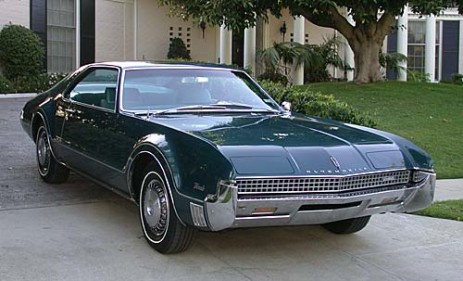
God, they were cool, each one of them in its own right. The most popular car in America in the late 1960s was the vanilla Impala from Generous Motors. There was so much more. My goodness, there was. Technical marvels and brute raw power.
I am going to get around to the Adventure of the Charger 400 R/T this morning, I swear, but there are too many damn cars, you know? I promise I will get to the Adventure in Bloomfield Hills of these mornings, but I will have to tell you about our Pony car first- the 1968 AMC Javelin 343. For a Rambler, that little car could scream.
Copyright 2014 Vic Socotra
www.vicsocotra.com
Twitter: @jayare303
Woodwarding
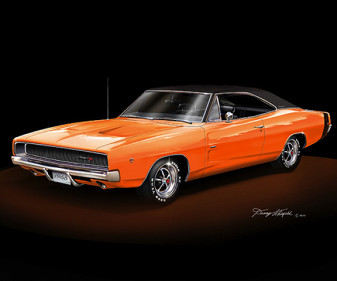
(1968 Charger 440 R/t. What a machine).
There is plenty to talk about this morning and I am not going to do it, regardless of the temptation. Instead, I want to talk with you about The Way It Was. It was all about the cars then, the really rapid Detroit iron that defined a decade completely and demonstrably surreal.
We drove those cars hard and we loved them in a way that kids today don’t seem to understand- like that commercial with the two hamsters driving some square hallucination of a real automobile, nodding along with some heavy bass tunes.
It evokes another time, that commercial does. All the cities had their mechanized promenades, back in the day. Whatever the Miracle Mile happened to be, the lines of cars filled with kids peering at each other, smoking cigarettes and holding beers down below the level of the window. Bruce Springsteen’s 1975 classic “Born to Run” anthem pretty much sums it up, “the highway was jammed with broken heroes on a last-chance power drive.”
Of course, the song didn’t emerge from the Jersey Shore until the collapse of the regime in Saigon and the shock-waves of the 1973 oil crisis ha begun to change the way we drove. I remember Mr. Nixon’s pronouncement that the national speed limit would henceforth be “55 MPH.”
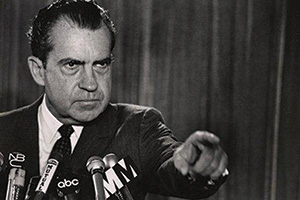
(Mr. Nixon decides we all drive “55”).
It was my first crisis as an almost adult, and dutifully tried to drive at that speed the next morning until an Olds with a cranky white guy at the wheel tried to insert himself into my tailpipe.
Fifty-five. Really. We were used to driving thirty miles an hour faster than that on the most routine of trips on the interstate.
And we drove. Mom and Dad bought a little condominium- a first in Michigan- in the mid-sixties at a little lake west of the Alpine Village of Gaylord, 250 miles north of Grabbingham. It was their first adventure in living the good life- there was an active social community on Martin Lake and each weekend, Raven would drag himself in from the American Motors HQ down on Plymouth Road to join up with the rest of us, standing around by the loaded Ambassador station wagon.
Raven would assume command, and we mounted up, one of us in the way-back with the bags and luggage, two in the back seat, and Mom and Dad in the front. Then we would join the great flow of traffic headed north, through Pontiac and Flint. There was no bridge at Zilwaukee then- there was a drawbridge on the interstate, and raising it to let the big boats head to the Dow Plant upriver made traffic jams that lasted hours. Then Bay City and Saginaw, through Claire (“Gateway to the North!) and the smaller towns in the sandy low hills and Grayling and finally the M-32 exit off I-75 in the dark.
The journey usually took around four hours and some change- Mom had the record time for the distance in three and a half hours, flat. So, in addition to the driving around we would do, and the trips over to Pat and Bud’s store in Elmira (Seed Potato Capital of Michigan!) we routinely put well over 500 miles on the cars on the weekends.
They still drive fast in Michigan. You can feel the difference between the states- Virginia moves along, Maryland pokes, Pennsylvania crawls with turnpike cops, Ohio is fierce, but once you make the big turn north in the Wolverine State, you can feel things open up and the foot gets heavy on the accelerator. Raven gave me the rules of the road as he was teaching me to drive, like he was an instructor pilot at Pensacola: “The cops will give you fifteen,” he said. Try to keep it a little under 85.”
Seriously. These days fifteen over gets you a ticket for reckless driving. Back then, it was just the margin of error. And of course we drove just as much in the winter, with the roads routinely covered with snow and ice. We all knew how to drive on the stuff, and just as fast. You just couldn’t use your brakes.
Anyway, As soon as I had my learner’s permit, Raven installed me behind the wheel of the family wagon, and I considered myself a veteran by the time I was approaching my 16th birthday, when I would be legal to drive all by myself. I commend my father for his forbearance. I remember teaching my sons to drive in Washington, and I think there are still dents on the floorboard of that 1992 Dodge Shadow Turbo from trying to apply the brake pedal I did not have on the passenger side- much less watching your teen-ager at the helm of the vast station wagon with the entire family aboard.
Nerves? You bet. But we learned fast, and the freedom that beckoned was positively intoxicating. So, I was going to bridge that context into the story of the Charger and the County Mounty, and realized I had not even mentioned VASCAR when I got dragged into updating some ancient information for a pal yesterday, and simultaneously got wrapped around the axle of 1967. It is too hard to just say “1967” and expect that anyone except an old fart would have the context for it.
In Grabbingham, two-a-day football practices started in August. We had just seen the National Guard depart the city a few weeks before in the wake of the 12 street riot, which was much more than that, and the second time I saw Raven go into defense mode.
The first time I experienced the impossible was in 1958 or ’59, when he built wooden covers for the little widows at the top of the basement walls with latches to seal them shut in the event of a nuclear attack on the Arsenal of Democracy. “In case I can’t get back from the office,” he said, in a perfectly matter-of-fact tone. “You will need to get these in place and stay down here until they sound the all clear. Popular Mechanics says it can help defeat beta radiation.”
My brother and I nodded back soberly. Our scout troop had recently toured one of the Nike Atlas missile defense batteries that were scattered around town, and we did the Civil Defense duck-and-cover drills at school. Seemed to make perfect sense.
The last week in July of 1967 I saw it again. The first reports were coming over the radio on Sunday morning, and he told me to get both cars over to the gas station and top them up in case we had to flee the city.
See? I was going to tell you a simple story about a neat car and a couple stupid young men, and I got lost in the lost world where it seemed presidents and candidates and civil rights leaders were just gunned down as a matter of course.
It is too vast to attempt to depict the reality of the fall of 1967- immediately after the riot, and before the complete freaking madness of 1968, much less the oil shock, and the way we lived, and the elements of class warfare.
So, I will get to the bit of trouble presently, but I was in the same Charger 440 R/T I was going to tell you about, and will, with my pal Dick at the wheel. It was a Saturday afternoon, and I wasn’t working at the Department Store for some reason. We had ventured outside our comfort zone- down Woodward and in the blue-collar town of Ferndale. We rarely went across Eight Mile, for the obvious reason that the cops there were nasty and still on edge.
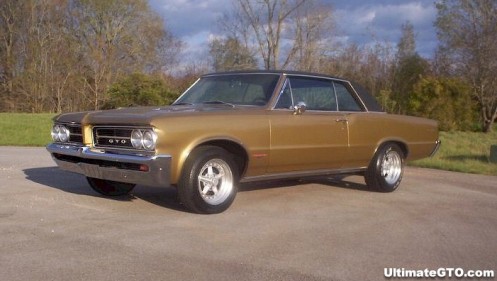
We pulled up to the light at Webster, I think, and an aggressive ethnic type- Italian, maybe- had a ’64 GTO that he obviously took a great deal of pride in, but from the Shade Tree Mechanic’s corner, not the race-tuning of the MoPar mechanics that Dick’s father had on the payroll.
The Stallion revved his engine at a light and Dick smiled wolfishly. We came off the line when the light changed and the Goat tried everything he had, staying on the right rear fender of the R/T for several seconds until he threw a piston. A belch of smoke from under the hood as his knots dropped off rapidly.
Dick backed off on the accelerator, and angled to the left to take one of the jug-handle turn-arounds and start back up the Avenue toward Royal Oak. I think we were originally headed for the White Castle, the only one in the immediate area, and thought better of it since we could still see the irate Goat driver with his hood raised.
We went instead to Mavericks, and let the carhop come out and take our orders- a Billy (⅓ pound cheeseburger), fries and a Coke was the usual.
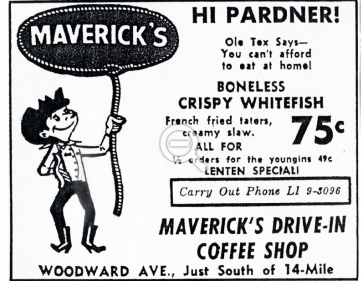
I was content to be a passenger, since I lost my license over what happened a few weeks before, and I was just over being grounded.
It was an amazing time. Some of the braggadocio that flew around Earnest W. Seaholm High School was about racing for “pink slips,” which was a charitable way of saying if you lost the winner got ownership of your car. I could only imagine what Mom would have done if I lost the title to the 1967 AMC Javelin in some display of idiocy.
Sometimes, in a tangential nod to the earlier topic, I am surprised that any of us survived long enough to vote.
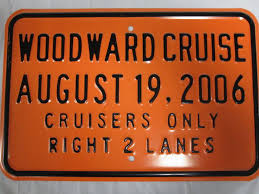
Copyright 2014 Vic Socotra
www.vicsocotra.com
Twitter: @jayare303
Chargers
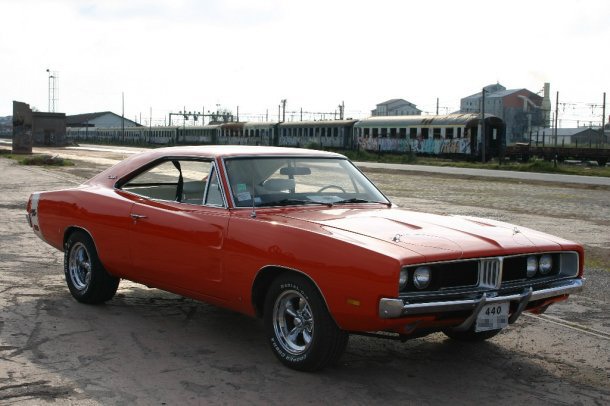
It was 1966 and my first scrape with the law. It did not go as disastrously as it could have, though the potential was certainly there for permanent physical mayhem and a significant black mark on my Permanent Record. In a way I benefitted from my callow age- just as the underage undocumented aliens are on the Southwest Boarder this summer.
As a father myself now, I marvel at the whole adventure, and wonder why Raven didn’t just knock my block off at the time.
I certainly would have been tempted in his position.
But let me digress before we get to the fun part and give you some context. There are two tracks to this, one in marketing and engineering, and the other purely social though closely related. The year was 1967 and the place is the northwest suburbs of Detroit, at the distant end of the famed Woodward Avenue. We had a riot. A big riot. The city was starting to die but we didn’t know it.
The new car models- the ‘68s- were on the street. There was a wave of high performance vehicles roaring down Woodward. The car companies were exploring new strategies to sell luxury and performance vehicles, and the specialty niche was filling up with some cars that were essentially ready for the track, right off the showroom floor.
“Little GTO” and “Won’t Come Back From Dead Man’s Curve” were on the AM radio on the dashboard- WKNR and CKLW, 80-thousand watts of power out of Windsor across the river to the south. The carmakers were exploring new ideas in the personal luxury and specialty car segments. Chrysler, fast to enter the specialty car market, selected their Dodge Division to enter the marketplace with a bigger model to fit between the wildly successful pony-car Mustang from Ford and the sleek personal luxury Thunderbird.
The T-bird had started out in 1955 as a sort of anti-Corvette in the market- good looking, sleek, sporty. Corvette went hard-core and the ‘Bird got longer and wider and comfier. Chrysler decided to us their B-body with a sporty fastback look that echoed the bizarre Marlin design from American Motors.
The fastback Charger was introduced in mid-season of the 1966 model year in direct retaliation to the Marlin, Mustang and sister ride Plymouth Barracuda. Marlin and Charger set a new standard for radical fastback design, though there was no question about who had the performance edge.
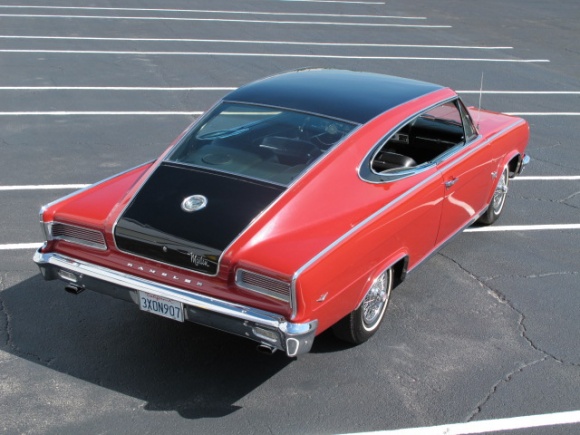
Both are strange-looking cars today. Dad’s pal Jim Alexander had the interior shop at AMC, and he and the boys at Chrysler tried for a space-age dash and functional interiors. For the 1968 model year, Chrysler updated the look to the one that would become eternal at the Duke’s of Hazzard “General Lee.”
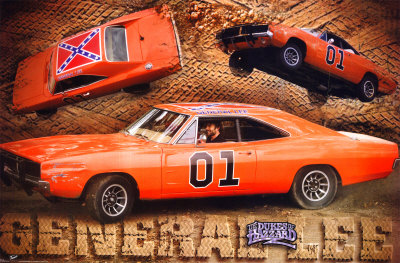
Back then, of course, it just looked edgy and totally cool. Chysler Designer Richard Sias developed an iconic look for his performance car, because that is the way the MoPar folks wanted to go: be the king of Woodward Avenue street racers. His Charger retained the full-width hidden headlight grille, and the taillights were updated to dual circular lamps at the direction of Styling Vice President, Elwood P. Engel. Dual scallops were added to the doors and hood to help accent the new swoopy lines.
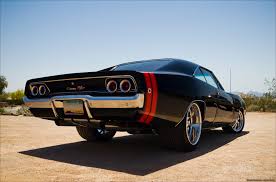
Inside, the interior had a major update- the console remained between the ergonometric front seats, but the rear seat became a standard bench. The tachometer was an option, and the smart money went for it- the other (and most critical) option is what you stuffed under the hood. The standard engine was the 318 cu in (5.2 L) two barrel carb. If you wanted to stand out at Maverick’s Drive-In or the TeePee or Ted’s, you went with the R/T model, with either the 440 Magnum engine or the monster 426 Hemi.
The stripes on the ass end were standard on the R/Ts and came in red, white or black. They could be deleted at no cost. The 1968 model year saw nearly 100,000 Chargers built, which included 17,000 R/Ts.
My pal Dick had the 440 R/t. It wasn’t his, of course. His Dad was a wheel down at Chrysler, and all the car execs, mine included, were entitled to bring home the hot models and let them be seen around town. In our case, the coolest we could get was the AMC Javelin, not a bad little car, and once we got a chance to campaign the very hot AMX. But frankly, everyone knew that some of the Chrysler execs were given access to fully race-tuned cars.
That was the social part. These cars were supposed to impose their will on the Mustangs and the GTOs and Firebirds and Mustangs and Camaros. The place they did it was on Woodward- four lanes of smooth concrete that ran from the River diagonally to the northwest through Detroit, Ferndale, Royal Oak and Birmingham.
Out beyond there, past the McManus,John & Adams Ad agency, and the stately Fox and Hounds Inn, the lights grew dimmer and you could really let those magnificent cars surge off the light and turn in some remarkable splits.
Can you imagine, these days that the car companies would send racing cars home to be driven by kids who just got their licenses?
I will have to get to that tomorrow, I am afraid. But let me tell you what a rush that Charger R/T was to drive. And we will have to talk about VASCAR, too. Timing is everything, as it turns out, and I am not talking about ETs for the quarter mile.
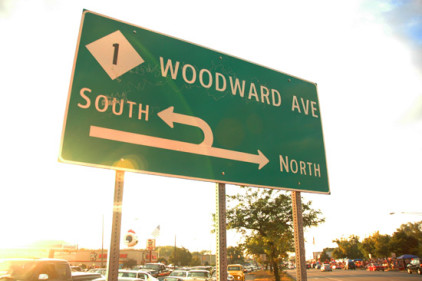
Copyright 2014 Vic Socotra
www.vicsocotra.com
Twitter: @jayare303
La Femme
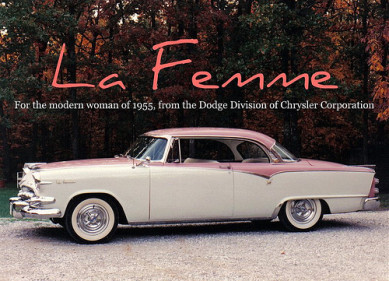
I am jet-lagged and punchy this morning. It had been a pretty good flight back into DCA- Ronald Reagan National on the signs- and we made it in between thunderstorms spawned by the Polar Vortex that is making this an unseasonably pleasant summer.
Given how surreal everything else is these days, I thought I might take a little digression on some surreal moments from the not-so-far past.
I was talking about the impromptu rumble seat that Dad cut out of our Nash Metropolitan. That led in short order to cruising around eBay motors to see what was out there. I am currently following an auction that has a few days to go- I won’t tell you which one so that you will not be tempted to false flag the process and drive up the cost, not that anyone ever does anything like that, but here is the little number I have been watching:
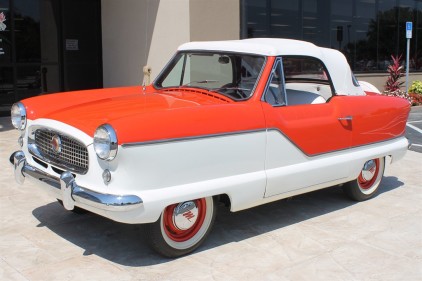
It doesn’t hurt to watch, right?
The only problem with that was the other car I was just watching- the 1973 Mercedes 350SL that I bought by mistake. Well, that is another story and all’s well that ends well, I suppose.
Anyway, I was researching the history of the cute little Metro and read about the marketing scheme. The Metro had a lot of things going for it, and one of the most important features George Mason was trying to sell was the concept of the “second car.” The sub-context in those prehistoric times was that it was intended to get Dad just to the train station to go into the City, or for the stay-at-home Mom to run errands. Hence the cuteness angle, baked in by the designers at Pininfarina at the independent coachbuilder at Cambiano, Italy.
I am certainly comfortable enough with the idea of flying around town in the proto-Smart Car of its day- easy to park, 30 MPG on the road, and all that- and would resent the idea that the car was designed to appeal to the women’s market in motor cars.
Some brands and models have been associated with subtle touches that implied a more gentle approach to design than say, a Charger 440 R/T with the Hemi. I am thinking budvases in the modern incarnation of the VW Beetle. I flogged a red 1968 hardtop Beetle for a hundred thousand miles back in the day, and a bud vase would have been the furthest thing from anyone’s imagination in those things.
I should add that classic as one of the cars I should have kept to pair up with the black-and-white convertible we called “Shamu” down in Florida. But I digress. Again. That is the problem with cars.
As part of the research into the Metro brand and ten year history of production, I came across something I had never run into- or run into me, rather, to be more precise. It was the first car specifically aimed at the motoring American woman.
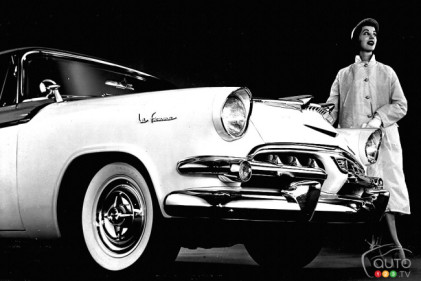
(Early advertising for La Femme. Original ad from Chrysler via Auto TV).
It was called “La Femme,” and was part of the 1955 Big Year for Chrysler motorcars. Chrysler was the smallest of the Big Three car companies, and despite the fact that everything that rolled, sold in the early 1950s, it took a major re-capitalization and organizational transformation to make Chrysler stay in the rear view of GM and Ford.
We Rambler people were proud of being one of the “Little Two” companies with Studebaker, not that it saved either in the long run. Nor in fact did it save Chrysler, which is owned by Fiat these days. But again, I digress.
Virgil Exner was the stylist in charge of the massive new roll out that was going to restore greatness to Chrysler. Dad talked about him in the same sort of reverence that he talked about GM’s Harley Earl: they were men who designed the sizzle into the American automobile. Earl’s greatest contribution might have been the Corvette, a vehicle that existed only because…well, because Harley thought it should exist.
Over at Chrysler, Exner was at the top of his game in 1955. The smooth new rides he created were ballyhooed in the late summer of 1954 in anticipation of the unveiling of the new Model year. The company hyped what was coming in un-illustrated black-and-white ads under the banner “The 100 Million Dollar Look.”
I know, I know. A hundred million bucks these days is viewed as a rounding error on the health care law, but it meant something back then, and the new car roll-out in the Fall was very much like Oscar Night in Detroit when the curtain came up on the new model year. Hard to believe now, but then it was a black tie event. Hell, you could even tell what company had built the car just by looking at it.
I defy anyone to do that today- and doubt further that anyone cares.
For 1955, Dodge/Chrysler had some technical marvels (the punch-button transmission was just one) and ten body styles in three series, divided into two door and four-door sedans, two door hardtops, two door wagons, four door wagons, and two door convertibles. The three series were the Coronet, the Royal and Custom Royal, the flagship of the Dodge line.
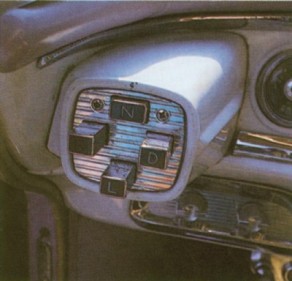
(Iconic Chrysler transmission buttons from a La Femme still in the wild, captured in Ypsilanti, MI by Steve Brown).
The Custom Royal Lancer had chrome rear fins and unique taillight and backup light bezels, plus a deluxe interior. The fender fins and sweep spear side trim were added to the late model year Custom Royal four door sedan trim package. But Virgil did not stop there. He made a Custom Royal Lancer that he thought would appeal to the female driving public. He called it the La Femme. It came with the slogan ”By Special Appointment to Her Majesty… the American Woman.”
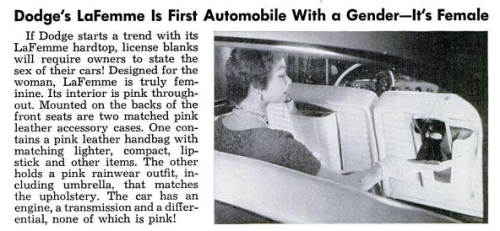
(Some contemporary commentary in the pages of Popular Mechanics. An adjoining article described how to build a scale model B-36 Bomber at home.)
The La Femme was mechanically not different than its brothers in the factory. What set it apart was a special trim option with Heather Rose and Sapphire White color combinations.
La Femme’s exterior also had special gold-colored “La Femme” script on the fenders. The vehicle’s interior was graced with special tapestry upholstery bearing pink rosebuds on a pale pink background and pale pink vinyl trim. A matching cape, boots, umbrella, shoulder bag, and floral tapestry-like fabrics were added as feminine niceties. Other accessories included a purse with compact, lipstick case, cigarette case, lighter and change purse. These accessories were color-coordinated to match the rosebud interior and were stored in compartments on the back of the front seats.
Over two years of production, roughly 2,500 Dodge La Femmes were built before the vehicle disappeared into the annals of automotive history. Obviously, Virgil Exner did not have female designers on his team, and there was nothing like the “focus groups” that would have evaluated his design then. The review team would be much more like the characters on Mad Men.
I think of it as a bunch of guys designing a car they thought women might like.
Freud had that one nailed, didn’t he? Guys are pretty much clueless.
Perhaps sixty specimens of the La Femme remain today, one of which is displayed at the Auburn Hills Chrysler headquarters complex. The Walter P. Chrysler Museum might be the best place to see one. It is certainly better than trying to tour the old Dodge Main plant in Hamtramck where they were built:
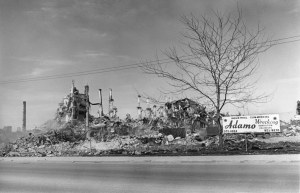
(The old Dodge Main Assembly Plant today, Hamtramck, MI.)
Copyright 2014 Vic Socotra
www.vicsocotra.com
Twitter: @jayare303
Car People
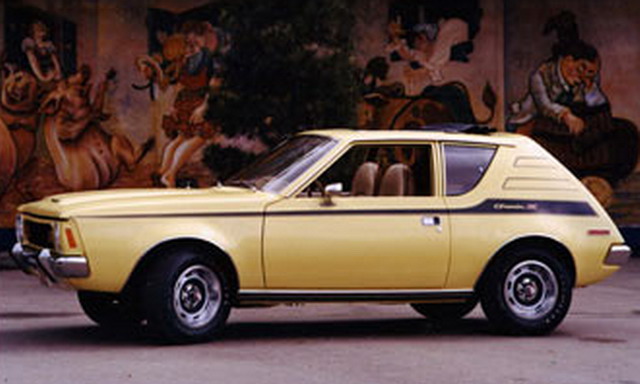
People- well, American people, of a certain age- love their cars. I wrote the other day about the quirky little Nash Metropolitan the family had back in the fifties. I wish we could have kept all the good ones.
A pal who lives Down Under wrote to comment that his “brother has kept his ’67 Pontiac Firebird with Mickey Thompson racing tires, Hurst 4 gear shifter, 450-something macking engine, and (I think) Cherry Bomb muffler…it truly growls. He also put in high performance suspension (a must for that car). I admire him for keeping it since he bought it second-hand in 1972 or ’73 (can’t remember for sure). He now has it in Oceanside, CA. For whatever reason, your story reminded me of the Gremlins.”
That got me going, again. The Rambler people were always a little eccentric.
We owned three Gremlins, a Pacer, a Javelin (my brother and I both broke 120mph in it), drove a host of Ambassador wagons, an American, and the Met. Dad sometimes got a new car every six months and had others for evaluation all the time- my favorite was an Avanti- just saw one on the road the other day and it brought back memories!
A guy who worked for Dad- Jim Alexander- was a big SCCA guy and managed to hook up Dan Gurney and the American Eagle team with some lunatics at AMC. Jim and Dad stayed pals all their lives- he and his wife would bring their camper up and park in the family compound in Up North Michigan each summer. Jim directed “interior design” at AMC, which means he was in charge of the doo-dads on the dash and the upholstery and seats.
It was a crazy world. We were at an AMC rally one year, and on display was the battered corpse of what had been a concept Marlin sedan in a “tropical” theme. Jim laughed and said it was the ugliest thing he had ever worked on- inside and out!
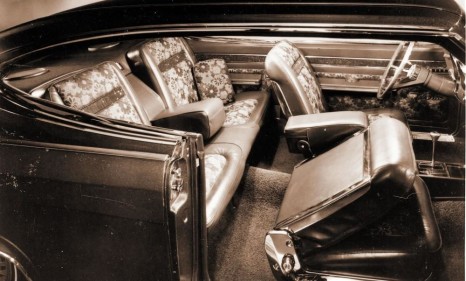
This was what it would have looked like on a better day.
Dad worked for AMC in one way or another from the early fifties to 1975 or so. It was so cool to NOT to have to drive a Rambler Ambassador. We did have a Javelin, though, ’67, and Dad borrowed an AMX for me to drive to the prom. The big wagons were tanks, indeed.
The Met was something special, though. They are still around on the collector’s market, but at this age, who needs that sort of challenge?
This one would be fun, though:
http://www.ebay.com/itm/Nash-Metropolitan-Convertible-1960-nash-metropolitan-convertible-/181459985175?forcerrptr=true&hash=item2a3fdba317&item=181459985175&pt=US_Cars_Trucks
Wish I could have kept the ’68 Beetle Convertible, the ’73 Chevy Caprice Classic, the ’75 Olds Delta 88 Royale, then nothing for a decade until I bound the ’73 the Mercedes 350SL, loved the 2003 SLK-350 and my soul, such as it is, will always be with the sleek Hubrismobile, the CLK-500 convertible.
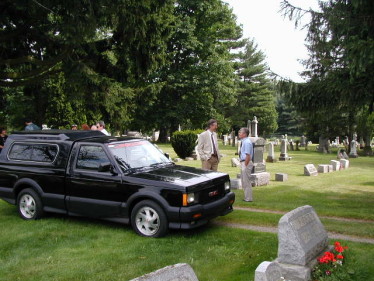
This is (one of) my follies. I restored Bomber Pilot Dick’s 1991 GMC Syclone pick-up truck in time to drive it to his funeral service, where this image was taken. My brother to the right. In it’s day, the 1,806 unit production-run turbocharged four-wheel drive truck could outrun a Maserati and was designed to crucify Shelby Cobra Mustangs on Woodward Avenue in Detroit in street combat.
It is still in the barn down in Culpeper. We were car nuts. Dick completed his 25 missions over Europe and never talked about it until he was in his 70s. I think “12 O’Clock High” offended him because he knew what a merciless meat grinder it really was. once he got back from the conflict he never drove a car that wasn’t the fastest in breed: Buicks, early on, the big ones, but later Corvettes and Jags. This was the truck he used to take things to the dump when he needed some cargo capability that could also smoke the split-times in the quarter mile.
I have that one, though, sigh, like my poor aging body, it needs work again. So does the 2004 Crown Vic Police Interceptor (pictured at the Brandy Station battlefield, largest Cavalry engagement in North American history), which is not nearly as nice looking as in the picture these days but I will get to fixing it up- a classic, last of the breed:
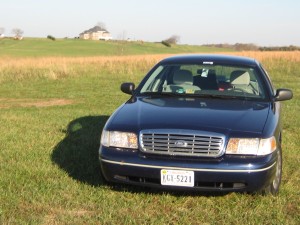
The P-71 Police Interceptor is sort of my daily city driver. People don’t mess with me. But more formal occasions- and long distance trips- require the precision and professionalism calls for the Panzer, which thankfully has it’s first dent and I no longer am insane about it. Shown coming back from Up North while the folks were failing, a key reason I bought it:

Can’t help it. I am a car guy. But here is what we rode around in in 1968:
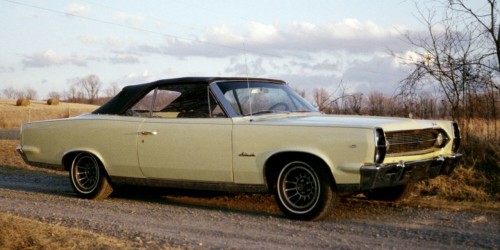
Style is style, right?
Copyright 2014 Vic Socotra
www.vicsocotra.com
Twitter: @jayare303
TAPS
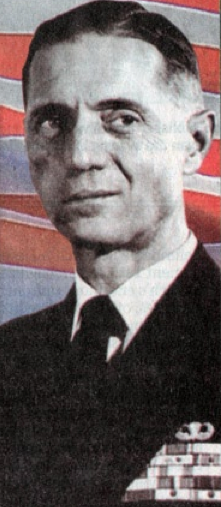
Another Great American left us over the weekend. This departure is worth noting on it’s own merit, but the death of RADM John Marocchi links us back to our pal Mac Showers. John was the senior surviving retired Naval Intelligence Admiral, and his story was a unique one. For the small community that cares about such things, here is how the obituary read:
12 July, 2014, RADM John L. Marocchi, USN-Ret. (94) of heart failure at Midlothian, VA. Born in Bologna, Italy, John Marocchi came to the United States with his family as a child. He felt a strong allegiance to his adopted country, and received an appointment to the US Naval Academy at Annapolis where he graduated in the class of 1942. His graduation date was accelerated to Dec. 19, 1941, just twelve days after the attack on Pearl Harbor. His first orders were to the pre-commissioning crew of the light cruiser USS Birmingham (CL-62) at NOB Norfolk.
After commissioning, the “Mighty B” escorted a convoy to Africa and became part of Operation HUSKY, the invasion of Sicily. The cruiser than shifted colors to the Pacific, where it gained eight additional battle stars and participated in the engagement off Bougainville (24 October 1944), where it absorbed hits from two Japanese torpedoes and an aerial bomb. Mighty B stayed in the fight, coming to the aid of the stricken carrier USS Princeton (CVL-23), blazing from previous battle damage, to render assistance in fighting the flames.
At 1523, as Birmingham came alongside, internal fires caused bombs to detonate violently, blowing off the carrier’s stern, showering the cruiser’s topsides with fragments. The explosion killed or wounded 649 men of the 1,200 man crew. Admiral Marocchi himself was injured severely and was hospitalized for 16 months of recovery. He bore his scars with honor the rest of his life.
Following WWII, he remained on active duty and attended the Naval Intelligence School at Anacostia. Subsequent tours included service in the Korean and Vietnam conflicts, including a tour as Fleet Intelligence Office on the staff of the Commander in Chief, Pacific Fleet.
Following a three-year tour in Germany as the DJ2 at USEUCOM, he was assigned to NSA at Fort Meade as one of two deputy directors. He retired in 1975 after 37 years of active service with many honors, including the Legion of Merit and the Purple Heart.
In retirement, he was active in the Naval Intelligence Professionals and on the Board of the Virginia War Memorial. Predeceased by his wife of 55 years, Mary P. Marocchi, his parents, brother and sister, and many, many friends and classmates, he is survived by his second wife, Harriette, his two daughters, Helen and Sory, five grandchildren and seven great-grandchildren. He preferred that any memorial contributions be made to the Virginia War Memorial in Richmond, VA.
Admiral Tom Brooks remarked “John had celebrated his 94th birthday on the 6th of June- the anniversary of D-Day- and was lucid and able to talk on the telephone as recently as Thursday.”
John was the dean of the Naval Intelligence Community (the Flag Officer with the earliest date of commission), having succeeded Mac Showers in that role when Mac passed away in October 2012.
RADM Don Harvey, USNA ’47, now succeeds as the dean of the Naval Intelligence community.
We understand that Admiral Marocchi will be buried at the National Cemetery at Culpepper, VA, but funeral arrangements are not complete. We will pass on further info as it becomes available.”
That ended the official communication- most of us retired spooks have Arlington National cemetery on the list of final destinations, but there are other alternatives. Fort Rosencrans National Cemetery atop Point Loma in San Diego always had a certain appeal, and there are still niches left for the placement of urns in the Colombarium. The view is spectacular, though naturally you can’t see much from the inside.
There is a network of national cemeteries to handle the nine million vets who served in World War Two, plus those of us on either side of history’s great divide. I was surprised- I don’t know why- to discover that Culpeper has its own National Cemetery. There is a good reason, and I should have known it.
During the Late Unpleasantness Between the States, the county and those adjacent were the scenes of savage fighting. Culpeper was a strategic railhead almost halfway between the warring capitals, and with hundreds of thousand of troops and hundreds of encounters, the dead were many and laid in makeshift graves where they fell.
Both sides used the town for winter quarters in between fighting, and the little town was the jumping off point for Lee’s Pennsylvania Campaign in 1863, and Grant’s Overland Campaign to capture Richmond in 1864.
The major battles included the great cavalry engagement at Brandy Station just to the north of town, Cedar Mountain just to the south, and The Wilderness and Chancellorsville to the east.
After the guns fell silent, a reburial program was initiated. In 1867, Culpeper National Cemetery was established to reinter many of the remains from the makeshift sites, most of them by the listed as “Unknown.” The caretaker’s lodge was erected in 1872 and made of solid brick in the Second Empire Victorian mode. As an added historical note, the structure was designed by Union Quartermaster General Montgomery Meigs. Who also was responsible for the Washington Aqueduct that still provides the drinking water for the Capital, and the structure is of historic value in its own right.
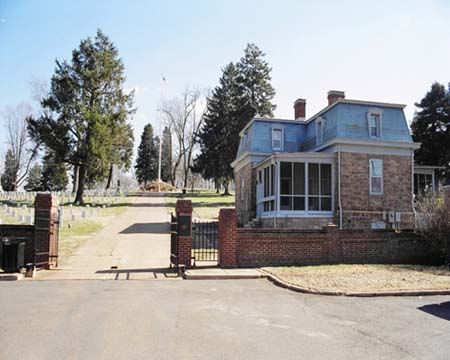
The thinking at the time was that the original six-acre plot was sufficient to future needs, and the last improvements to the infrastructure were made by the Roosevelt Administration in the 1930s- straightening the headstones, that sort of thing.
That was basically all that happened to the National Cemetery in what was now a strategic nothing, just a sleepy little junction town. Having operated without any major improvements since the New Deal, and out of space with the addition of the veterans of the Spanish and First Wars, the cemetery was closed to new interments on November 17, 1972.
Obviously there was a growing need to accommodate the veterans of The Big One, and the cemetery was transferred from the Department of the Army to the smoothly efficient management of the Veteran’s Administration. Property was donated by the VFW and other interested parties, and there is now plenty of room for veterans of all past and future wars.
Admiral Marocchi lived his last years in Midlothian, VA, not far away, but light years from the officious bustle of Washington. I think he might be onto something regarding ultimate destinations. Next time I am down at the farm, I am going to check it out seriously.
I mean, why not? Who would want to stay in DC for eternity with that sort of traffic?
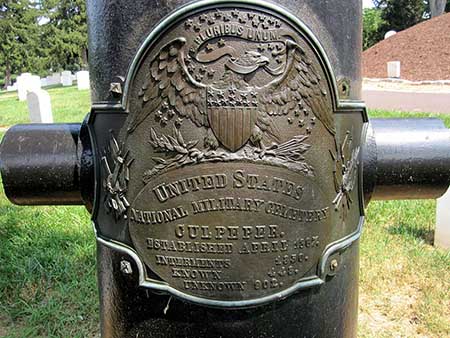
(Union Cannon mounted as a monument, Culpeper National Cemetery).
Copyright 2014 Vic Socotra
www.vicsocotra.com
Twitter: @jayare303
Metropolitan Story
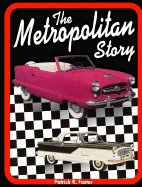
I am going to write about the beloved Nash Metropolitan this morning. It is, I think, a non-controversial topic on which to write. I was thinking about it in the course of marveling at the news that we are going to spend abut $67,000 a year on undocumented Dreamers, of whom we understand we will be hosting 125,000 by the end of this year.
A Metropolitan then had a price-point of about $1,500 bucks. It is tempting to say that we could give those children sixteen years or above forty new cars to drive back home, but of course in constant dollars, the appropriate way to calculate relative worth across the years, it is only about three new compact cars.
But never mind. I used to hear that the war in SE Asia cost enough to buy are the Vietnamese a new Ford Mustang, so I guess it is something to keep in mind. This is supposed to be non-controversial, so let’s drive on.
Patrick Foster, a tireless chronicler of the American Motors marque, did a nice book on the subject, “The Metropolitan Story.” My father Raven was a source for much of the material, having been the assistant head of Design for the American Motors consortium in the time. They became great pals, and I strongly urge you to check out Patrick’s many books and articles if you have an interest.
I remember vividly an early Metropolitan story- we owned one, of course, and that was just after the time that Dad taught Mom how to drive.
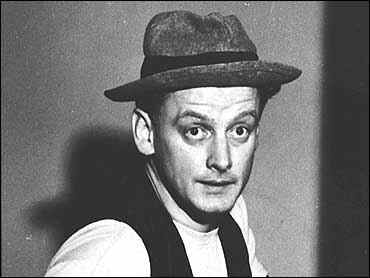
It is funny to look back more than a half century to times that that- sort of like watching the gray-white kinescope record of Jackie Gleason’s The Honeymooners, when he and New York Sanitation Worker buddy Ed Norton worried about things like whether they could afford a telephone land line.
Seriously. That is how much and how fast that old world has faded away. I noticed the discontinuity years ago- that people on public assistance today have so much more in creature comforts than the generation that grew up in the New Deal, fought the Good War, and came back to an America that was roaring with energy.
To get telephones and deal with a magical new world filled with challenge, opportunity and the Red Menace.
I remember some of that stuff, but nothing as vivid as Raven producing a coping saw one afternoon and announcing that day in 1957 that he was going to put a trunk in the Metropolitan.
OK- a quick step back. The Metro was the first little car on the modern American road. It was the brainchild of George Mason, the automobile one, who decided to buck the Detroit iron trend of “lower, longer, bigger faster” and produce what was envisioned as something else pretty new: a second car for the American Family. It was one of the first cars produced with an eye to the women’s market- another quite new thing.
You know, a car for Mom to take the kids to school or run errands in the increasing suburban sprawl. Anyway, there was a project car called the Nash Experimental International- the NXI- which was renamed on introduction to be the Metropolitan to better evoke the concept.
The reality was quite different. This was a contract deal with the Austin Motor Company in Britain (among others) and would be the first motor car intended for the North American Market to be built entirely in Europe.
On it’s introduction, the little car was intended to be a miniature version of the big Hudson and Rambler six-passenger sedans. Mechanix Illustrated’s automotive editor Tom McCahill (the Illustrated was always around Dad’s workshop each month as a source for projects) said “It is not a sports car by the weirdest torturing of the imagination but it is a fleet, sporty little bucket which should prove just what the doctor ordered for a second car, to be used either for a trip to the movies or for a fast run to a penicillin festival.”
I have no idea what he meant by the last, but he added that it was a “nice-handling car with plenty of control and amazing dig, considering it is powered by a small Austin A-40 engine.” He reported that his test car accelerated from zero-to-sixty in a bit under 20 seconds, and topped out at slightly over seventy miles an hour.
His biggest gripe was that although the finish was “very nice,” having no trunk opening was a problem. In typical quirky British fashion, the only way to get to the storage in the “boot” was by pulling the front seat forward, leaning into the back seat area (charitably termed tiny) and pulling down the back of the rear seat. He was not alone. Motor Trend said the rear “utility” seat was “a joke.”
I think ours was a 1956 or earlier. The color was about what you see here:
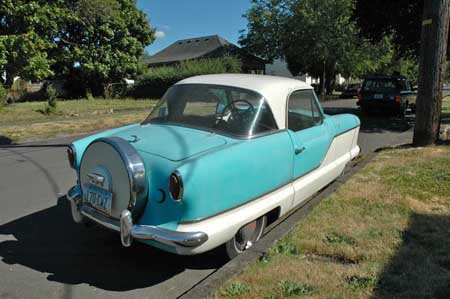
The trunk you see was the project of the weekend for Dad. With the 4th generation Metros coming along, they fixed the trunk access problem and the replacement hardware was available through the Company garage, and he decided to do the job himself. So, out with the saw and off came the back deck.
Attaching the hardware and doing the finish work was going to take some additional time, so he decided to take the family for a drive while we had a rumble seat. The grown up were in the front seats and the three kids jumped in the trunk. Dad decided on a drive out to country and a special treat: a stop at Ted’s Drive In at the intersection of Maple Street and US-24, the Telegraph Road.
Dining out was not something we did a lot, so this was a huge treat, not the least of which was poking our head’s out of the cute little car and waving at people as we whizzed by.
Ted’s was Michigan’s first drive-in was located near Square Lake Road in Bloomfield Hills. The original was a lunch wagon near the Peace Bridge in Buffalo, the same town that gave us the Beef-on-Weck sandwich that Tracy O’Grady now brings us on the last Friday of the month at the Willow restaurant.
The one we knew in Michigan opened in 1954 on US-24 and was known as the home of “the worlds largest char broiled hot dog,” Their fries were to die for- or at least they were in the opinion of this eight year old, and the little plastic tubs of catsup were quite unlike anything that came out of a bottle of Heinz 57 in Mom’s refrigerator.
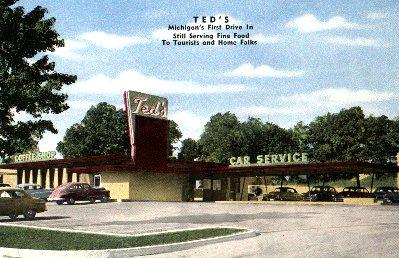
We had a nice afternoon lunch- inside, as I recall, and then motored back to Grabbingham with the wind in our hair. Mom was going to finally be able to get the groceries out of the trunk while still maintaining control on her unruly brood.
Eventually we replaced the Metro with a Rambler American- a much more functional car for the kids much larger kids. It is another one I wish we had kept. I wish Ted’s were still there for a pit-stop on the way into the old home town from the interstate. But it is gone now, though apparently some locations remain in Buffalo and Arizona, for some reason.
They tore the place down, but the intersection was still a hot spot for fine dining. In fact, the Machus Red Fox at 6676 Telegraph Road was one of the restaurants that replaced it as a destination. A little more upscale, of course, which is why Jimmie Hoffa, former President of the Teamster’s International Union went there to meet with some associates in the afternoon of July 30th, 1975.
It would have been Jimmy’s last trip to any sort of restaurant, and they have been looking for him, ever since. But of course, that is a different story. Same place. Different story, but it does involve cars.
Copyright 2014 Vic Socotra
www.vicsocotra.com
Twitter: @jayare303
